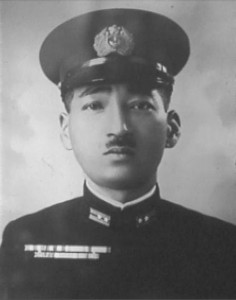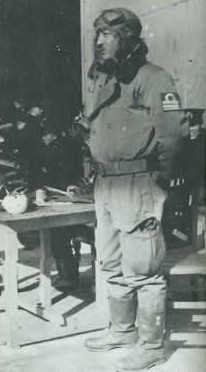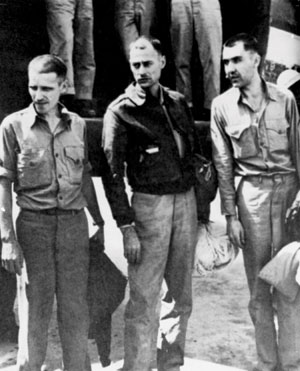Mitsuo Fuchida: A Forgotten Story of Faith
 Recently, as I was driving into town with one of my grandsons to have lunch, he mentioned to me that it was December 7th, the day in 1941 when Pearl Harbor was attacked by the Japanese. My grandson really likes history, so I'm not surprised he mentioned the significance of the date. I asked him if he knew the story of Captain Mitsuo Fuchida (1902-1976) of the Imperial Japanese Navy Air Service. He didn't.
Recently, as I was driving into town with one of my grandsons to have lunch, he mentioned to me that it was December 7th, the day in 1941 when Pearl Harbor was attacked by the Japanese. My grandson really likes history, so I'm not surprised he mentioned the significance of the date. I asked him if he knew the story of Captain Mitsuo Fuchida (1902-1976) of the Imperial Japanese Navy Air Service. He didn't.
One thing I've noticed with the passing of years is that Christian children have very little knowledge of their Christian heritage and the heroes of the faith. If parents don't pass on our Christian history, the youth won't know these remarkable examples of faith in action. The youth certainly won't receive this instruction at church.
Pearl Harbor
Captain (海軍中佐) Fuchida 1 had risen through the ranks of the Japanese Naval Air Force while logging over 10,000 hours of flight time, mostly from the decks of Japanese aircraft carriers. He had gained extensive military service during Japan’s expansion into China. As a result he was chosen to help plan and then to lead the air assault on Pearl Harbor.  At 06:00 hours, Captain Fuchida led the first wave of 183 attack aircraft towards Pearl Harbor. At 07:40 he opened his cockpit and fired a green flare into the air to let the other Japanese pilots know the attack was to proceed as planned. At 07:49, he ordered his pilot Lieutenant Mitsuo Matsuzaki to send the radio signal "Tora! Tora! Tora!" to flagship Akagi, informing them that the attack was commenced with total surprise; Tora was the acronym for totsugeki raigeki, "torpedo attack" and in Japanese Tora means tiger. He remained over Pearl Harbor until the second wave of attack finished to see the extend of the damage to the US military installations. His plane was hit 21 times by anti-aircraft fire. It was amazing that his plane did not crash. Because of the success of the mission, he was granted an audience with Emperor Showa (昭和天皇).
At 06:00 hours, Captain Fuchida led the first wave of 183 attack aircraft towards Pearl Harbor. At 07:40 he opened his cockpit and fired a green flare into the air to let the other Japanese pilots know the attack was to proceed as planned. At 07:49, he ordered his pilot Lieutenant Mitsuo Matsuzaki to send the radio signal "Tora! Tora! Tora!" to flagship Akagi, informing them that the attack was commenced with total surprise; Tora was the acronym for totsugeki raigeki, "torpedo attack" and in Japanese Tora means tiger. He remained over Pearl Harbor until the second wave of attack finished to see the extend of the damage to the US military installations. His plane was hit 21 times by anti-aircraft fire. It was amazing that his plane did not crash. Because of the success of the mission, he was granted an audience with Emperor Showa (昭和天皇).
Battle of Midway
During the Battle of Midway, Capt. Fuchida was not able to participate because he had appendicitis. However, he did observe the progress of the battle from the carrier Akagi, and later he wrote a book entitled, Midway: The Battle That Doomed Japan, the Japanese Navy’s Story. When the Akagi was hit by American aircraft, he had to evacuate the bridge by lowering himself down by a rope. An explosion then occurred throwing him to the deck, breaking both ankles. He was rescued and later treated.
Hiroshima
On August 5th 1945, Fuchida was in Hiroshima attending a military conference when he was abruptly summoned to Tokyo. On August 6th, the US military dropped an atom bomb on the city. The following day, Fuchida was part of an assessment team who went to Hiroshima to survey the damage. All of the assessment team eventually died from radiation poisoning except for Fuchida.
Peggy Covell
 |
| Peggy is upper left corner |
Following the war, Gen. Douglas MacArthur summoned Fuchida to testify in Tokyo. He was disgusted with the idea of war trials and thought that everyone should know that war was war and that cruel acts occurred on both sides. He believed the Americans were certainly as cruel towards their captives as the Japanese were. However, he met his former flight engineer Kazuo Kanegasaki at Uraga Harbor who told him that he was treated well as a prisoner of war. Kanegasaki recounted that Peggy Covell, 2 who cared for Japanese prisoners, had parents who had been missionaries and were captured by Japanese soldiers. In fact, before the soldiers beheaded them, her parents asked for and were granted 30 minutes to pray for their executioners.
Peggy’s parents were missionary teachers in Japan until 1939, when they departed for safety reasons to the Philippines and sent their children on to the United States. Eventually, the parents were captured by the Japanese and executed Sunday morning, December 19, 1943. Fuchida could not understand why they would pray to a god who could not save them from the sword. Why would the Covell parents pray for their enemies who would shortly behead them? Why would Peggy return to Japan to assist with the Japanese POWs? She claimed, “Because Japanese soldiers killed my parents.’’ Kanegasaki could not provide an answer for Fuchida. In Fuchida’s moral framework, the duty of virtue required revenge to prove loyalty to a loved one whose honor had been disgraced. In Peggy’s case Fuchida saw no rationale for Peggy’s forgiveness or a higher obligation to love someone, especially an enemy.
Jacob DeShazer
 In 1948 Fuchida was again ordered to testify. Near the Hachiko statute next to the Shibuya station in Tokyo, a Western man handed him a pamphlet entitled, I Was A Prisoner In Japan. It recounts the story of Jacob DeShazer who was one of General Doolittle Raiders whose B-25 planes bombed Japan during 1942. 3
In 1948 Fuchida was again ordered to testify. Near the Hachiko statute next to the Shibuya station in Tokyo, a Western man handed him a pamphlet entitled, I Was A Prisoner In Japan. It recounts the story of Jacob DeShazer who was one of General Doolittle Raiders whose B-25 planes bombed Japan during 1942. 3
Jacob DeShazer was the bombardier of B-25 No.16.  It departed from the deck of the carrier the USS Hornet and dropped its bombs over Nagoya, Japan. Because they wouldn’t have enough fuel to return to the carrier, the plan was to fly to safety in China. A large jagged hole in the plastic windshield created wind drag on the B-25, slowing it down. As a result, they ran out of fuel over Ningbo (宁波), China, and they had to parachute into this Japanese-controlled part of China. The Japanese captured them and DeShazer was in several POW camps for 40 months, 34 of the months were solitary confinement. He was beaten, malnourished and three of the crew were executed by a firing squad. A fourth member, Lt. Bob Meder, died of starvation.
It departed from the deck of the carrier the USS Hornet and dropped its bombs over Nagoya, Japan. Because they wouldn’t have enough fuel to return to the carrier, the plan was to fly to safety in China. A large jagged hole in the plastic windshield created wind drag on the B-25, slowing it down. As a result, they ran out of fuel over Ningbo (宁波), China, and they had to parachute into this Japanese-controlled part of China. The Japanese captured them and DeShazer was in several POW camps for 40 months, 34 of the months were solitary confinement. He was beaten, malnourished and three of the crew were executed by a firing squad. A fourth member, Lt. Bob Meder, died of starvation.
During DeShazer’s time in prison, as he saw the cruelty of his captors, he developed a deep hatred towards them. After approximately 25 months, he asked his guards for a copy of the Bible. He was allowed to have it for only 3 weeks. In the POW camp he read the Bible, and he accepted the message of salvation through Jesus Christ and it changed his life completely. He began to learn Japanese and to treat his captors with respect. The guards responded positively. He resolved to someday bring the message of salvation to Japan. Ten days after the atomic bomb on Hiroshima, American soldiers parachuted into the POW camp in Beijing, China, freeing him. DeShazer returned to the USA and attended Seattle Pacific College, now known as Seattle Pacific University. 4 He returned to Japan to preach the gospel. Eventually, he established a church in Nagoya, the very city he had bombed years before.
Salvation
The examples of Peggy Covell and Jacob DeShazer created a desire in Fuchida to know more about the Christian god. In 1949, Fuchida purchased a Bible near the same Shibuya Station where he had received the pamphlet. As he read the gospels, he came to understand the reason for the forgiveness that motivated Peggy and Jake. It was the crucifixion of Jesus and his words in the gospel of Luke, “Father, forgive them, for they do not know what they are doing.” On April 14, 1950, he accepted Christ as his Savior. In May he went to where DeShazer resided and knocked on the door. DeShazer answered and Fuchida said, "I have desired to meet you, Mr. DeShazer. My name is Mitsuo Fuchida." After a moment, DeShazer recognized the name and said, "Come in, come in." The former enemies embraced as brothers in Christ. Fuchida spent the rest of his life as an evangelist. His booklet, From Pearl Harbor to Calvary, recounts his journey to faith.











